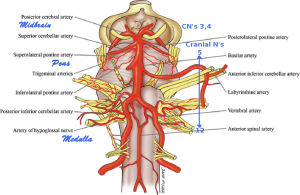VBI
Vertebro-basilar Insufficiency
- a clinical syndrome caused by transient ischaemia of the vertebrobasilar circulation, formed by the vertebral and basilar arteries, which forms the posterior circulation of the brain.
- vertebrobasilar arteries supply the cerebellum, medulla, midbrain, and occipital cortex
- most commonly caused by atherosclerosis and/or embolism. Embolism is uncommon in vertebral arteries
Presentation
- vertigo, dizziness,syncope, drop attacks
- diplopia, visual field deficits, blindness
- ataxia, imbalance, dysmetria are common
- dysphagia, dysarthria are common
- contralateral weakness
- ipsilateral cranial N involvement when present
Vertebral artery STROKE is associated with a variety of syndromes
- Locked in syndrome
- Lateral medullary syndrome
- Internuclear ophthalmoplegia
- Cerebellar infarction
- Medial medullary syndrome
- Posterior cerebral artery occlusion
Management
- as for TIA in general although vertebral artery TIA/stroke less commonly atherosclerotic in nature and endarterectomy/stent therefore less likely. The more distal from the brain the more likely.
- angioplasty for basilar artery disease is not uncommon
- as for TIA, prevention is key and risk stratification is central
- control of hypertension, diabetes
- management of arrhythmias
- lipid lowering
- blood thinners
References include:
https://radiopaedia.org/articles/vertebrobasilar-insufficiency?lang=gb
https://www.ncbi.nlm.nih.gov/books/NBK482259/
http://www.dizziness-and-balance.com/disorders/central/strokes/tia.html
